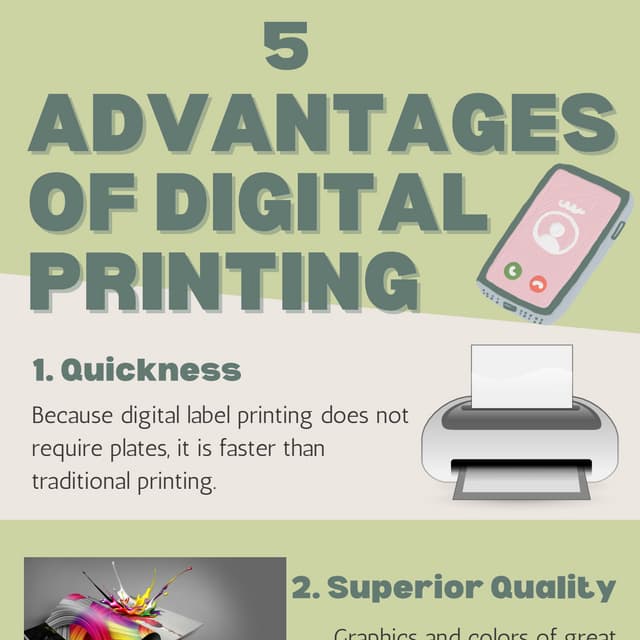Unknown Facts About Digital Printing
Unknown Facts About Digital Printing
Blog Article
Digital Printing Can Be Fun For Everyone
Table of ContentsAbout Digital PrintingAll About Digital PrintingThe 25-Second Trick For Digital PrintingThe Main Principles Of Digital Printing Not known Details About Digital Printing The 5-Minute Rule for Digital Printing
Variable information printing, such as straight mail with personalized codes and addresses, is ideally suited for electronic printing. Digital fast printing only needs 4 actions of layout, testimonial, printing and binding to obtain every little thing done. Digital fast printing has an unequaled advantage: print on demand.According to PMMI, electronic printing allows brands and producers to respond swiftly to consumer needs while improving the supply chain, reducing warehousing price and waste, and taking pleasure in faster time to market. That all sounds terrific, but just how does this technology do all that? The major differentiator of these innovations is that there are no set up charges and no plates with digital printing.
The Only Guide for Digital Printing
According to Wikipedia, the best distinction between digital printing and typical techniques such as lithography, flexography, gravure, or letterpress - Digital Printing is that there is no requirement to replace printing plates in digital printing, whereas in these analog printing methods the plates are repeatedly replaced. This leads to quicker turnaround time and decreases expense when using electronic printing.
Digital printing is extremely flexible, so it's simple to make changes to the package style quickly. It all goes back to the plates.
Much more stock can mean more waste down the road. With traditional printing methods, short-run printing is just not possible. Due to the fact that a great style can make or damage your product, electronic printing regularly produces high-quality, clear and colorful graphics each time. Digital printing on versatile pouches includes the bright, dynamic, and precise graphics that almost beckon consumers to connect and touch them.
Digital printing is the procedure of printing digital-based images straight onto a variety of media substrates. There is no need for a printing plate, unlike with balanced out printing. Digital files such as PDFs or desktop computer posting documents can be sent out directly to the digital printing press to print theoretically, photo paper, canvas, material, synthetics, cardstock and other substrates.
Not known Facts About Digital Printing
According to PMMI, electronic printing permits brands and manufacturers to respond promptly to client needs while improving the supply chain, lowering warehousing cost and waste, and appreciating faster time to market. That all audios terrific, however how does this innovation do all that? The significant differentiator of these innovations is that there are no set up charges and no plates with digital printing.
According to Wikipedia, the best difference in between digital printing and traditional methods such as lithography, flexography, gravure, or letterpress is that there is no demand to replace printing plates in digital printing, whereas in these analog printing techniques the plates are repetitively replaced. This causes quicker turn-around time and decreases expense when making use of electronic printing.

The Ultimate Guide To Digital Printing
A lot more inventory can imply even more waste down the road. With standard printing methods, short-run printing is just not feasible. Due to the fact that a fantastic style can make or break your item, digital printing consistently develops high-quality, clear and vivid graphics each time. Digital printing on flexible pouches includes the intense, vibrant, and precise graphics that almost beckon customers to connect and touch them.

According to PMMI, digital printing allows brand names and makers to react quickly to consumer demands while improving the supply chain, lowering warehousing expense and waste, and appreciating faster time to market. That all sounds terrific, but exactly how does this modern technology do all that? The major differentiator of these modern technologies is that there are no set up my latest blog post fees and no plates with electronic printing.
The Best Strategy To Use For Digital Printing
According to Wikipedia, the greatest difference in between electronic printing and typical methods such as lithography, flexography, gravure, or letterpress is that there is no need to change printing plates in digital printing, whereas in these analog printing techniques the plates are consistently changed. This leads to quicker turnaround time and decreases cost when using electronic printing.
Digital printing is extremely flexible, so it's easy to make adjustments to the bundle layout promptly. It all goes back to the plates.

Getting The Digital Printing To Work
Digital printing More hints is the process of printing digital-based photos straight onto a range of media substrates. There is no need for a printing plate, unlike with offset printing. Digital data such as PDFs or desktop computer publishing documents can be sent out directly to the digital printing machine to publish on paper, image paper, canvas, material, synthetics, cardstock and other substrates.
Report this page